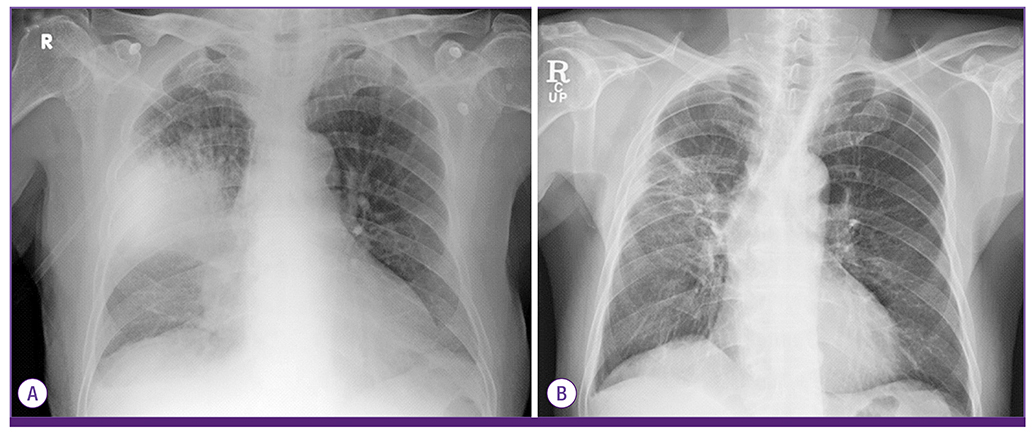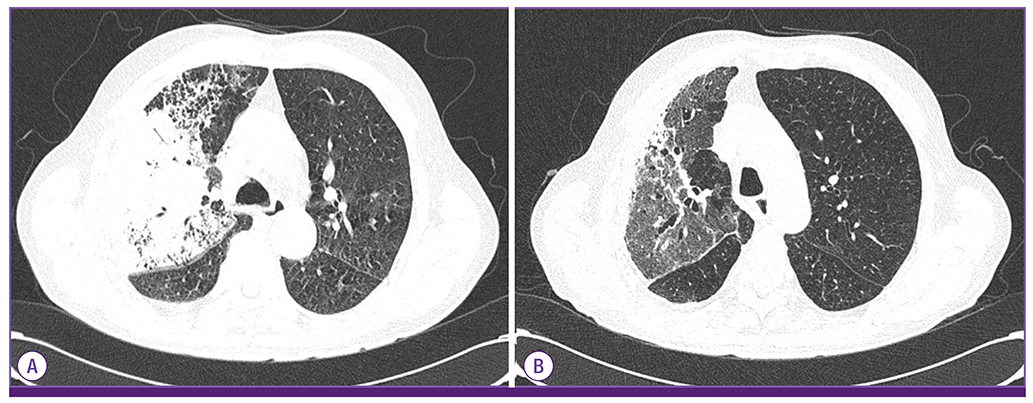Infect Chemother.
2017 Dec;49(4):297-300. 10.3947/ic.2017.49.4.297.
A Case of Community-Acquired Pneumonia Caused by Multidrug-Resistant Acinetobacter baumannii in Korea
- Affiliations
-
- 1Department of Internal Medicine, Yonsei University College of Medicine, Seoul, Korea. smileboy9@yuhs.ac
- 2AIDS Research Institue, Yonsei University College of Medicine, Seoul, Korea.
- KMID: 2399199
- DOI: http://doi.org/10.3947/ic.2017.49.4.297
Abstract
- Acinetobacter baumannii is an aerobic Gram-negative coccobacillus that causes nosocomial pneumonia in patients on mechanical ventilation or previously treated with broad-spectrum antibiotics. Nevertheless, community-acquired pneumonia (CAP) caused by A. baumannii, especially multi-drug resistant (MDR) strains, is rare. We experienced the first case of CAP caused by MDR A. baumannii in Korea in a 78-year-old man. This case shows that MDR A. baumannii can cause CAP in Korea.
MeSH Terms
Figure
Reference
-
1. Fournier PE, Richet H. The epidemiology and control of Acinetobacter baumannii in health care facilities. Clin Infect Dis. 2006; 42:692–699.
Article2. Towner KJ. Acinetobacter: an old friend, but a new enemy. J Hosp Infect. 2009; 73:355–363.3. Leung WS, Chu CM, Tsang KY, Lo FH, Lo KF, Ho PL. Fulminant community-acquired Acinetobacter baumannii pneumonia as a distinct clinical syndrome. Chest. 2006; 129:102–109.
Article4. Papp-Wallace KM, Endimiani A, Taracila MA, Bonomo RA. Carbapenems: past, present, and future. Antimicrob Agents Chemother. 2011; 55:4943–4960.
Article5. Kang SJ, Kang CI, Park SY, Ha YE, Joo EJ, Chung DR, Peck KR, Lee NY, Song JH. Epidemiology and clinical features of community-onset Acinetobacter baumannii infections. Infect control Hosp Epidemilo. 2012; 33:1053–1055.
Article6. Falagas ME, Karveli EA, Kelesidis I, Kelesidis T. Community-acquired Acinetobacter infections. Eur J Clin Microbiol Infect Dis. 2007; 26:857–868.7. Richet HM, Mohammed J, McDonald LC, Jarvis WR. Building communication networks: international network for the study and prevention of emerging antimicrobial resistance. Emerg Infect Dis. 2001; 7:319–322.
Article8. Lee K, Kim MN, Kim JS, Hong HL, Kang JO, Shin JH, Park YJ, Yong D, Jeong SH, Chong Y. KONSAR Group. Further increases in carbapenem-, amikacin-, and fluoroquinolone-resistant isolates of Acinetobacter spp. and P. aeruginosa in Korea: KONSAR study 2009. Yonsei Med J. 2011; 52:793–802.
Article9. Han SH, Na DJ, Yoo YW, Kim DG, Moon YR, Moon KM, Lee YD, Cho YS, Han MS, Yoon HJ. A case of probable community acquired Acinetobacter baumannii pneumonia. Tuberc Respir Dis (Seoul). 2007; 63:273–277.
Article10. Kang CI, Song JH, Oh WS, Ko KS, Chung DR, Peck KR. Asian Network for Surveillance of Resistant Pathogens (ANSORP) Study Group. Clinical outcomes and risk factors of community-acquired pneumonia caused by gram-negative bacilli. Eur J Clin Microbiol Infect Dis. 2008; 27:657–661.
Article11. Na JY, Min BW, Chung SH, Kim MY, Lee YJ, Park JT, Kim HS. A probable community-acquired pneumonia due to Acinetobacter baumannii infection presenting the positive pneumothorax test at autopsy. Korean J Leg Med. 2010; 34:125–128.12. Lee Y, Yoon S, Lee HS, Kang BH, An J, Kim YJ, Hong SB, Choi SH. A case of severe community-acquired Acinetobacter baumannii pneumonia with bacteremia. Infect Chemother. 2012; 44:71–74.
Article13. Oh YJ, Song SH, Baik SH, Lee HH, Han IM, Oh DH. A case of fulminant community-acquired Acinetobacter baumannii pneumonia in Korea. Korean J Intern Med. 2013; 28:486–490.
Article14. Ong CW, Lye DC, Khoo KL, Chua GS, Yeoh SF, Leo YS, Tambyah PA, Chua AC. Severe community-acquired Acinetobacter baumannii pneumonia: an emerging highly lethal infectious disease in the Asia-Pacific. Respirology. 2009; 14:1200–1205.
Article15. Anstey NM, Currie BJ, Withnall KM. Community-acquired Acinetobacter pneumonia in the Northern Territory of Australia. Clin Infect Dis. 1992; 14:83–91.
Article16. Kempf M, Rolain JM. Emergence of resistance to carbapenems in Acinetobacter baumannii in Europe: clinical impact and therapeutic options. Int J Antimicrob Agents. 2012; 39:105–114.
Article17. Lee CS, Doi Y. Therapy of infections due to crbapenem-rsistant Gram-ngative pthogens. Infect Chemother. 2014; 46:149–164.
Article18. Zavascki AP, Bulitta JB, Landersdorfer CB. Combination therapy for carbapenem-resistant Gram-negative bacteria. Expert Rev Anti Infect Ther. 2013; 11:1333–1353.
Article
- Full Text Links
- Actions
-
Cited
- CITED
-
- Close
- Share
- Similar articles
-
- A case of fulminant community-acquired Acinetobacter baumannii pneumonia in Korea
- A Probable Community-Acquired Pneumonia due to Acinetobacter baumannii Infection Presenting the Positive Pneumothorax Test at Autopsy
- A Case of Probable Community Acquired Acinetobacter baumannii Pneumonia
- A Case of Infective Endocarditis Caused by Community-Acquired Acinetobacter baumannii
- Extreme Drug Resistant Acinetobacter Nosocomial Ventilator-Associated Pneumonia Treated Successfully with Tigecycline and Amikacin in Intensive Care Unit: A Case Report



